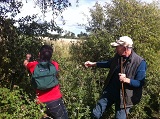
Whilst out walking I’ve had my eye on what is in fruit and what is not. Mainly from my own wild eating whilst walking in the wilds perspective.
It does make me wonder slightly the point/ fine line between foraging and taking some and also as important just how much you should know of what exactly you are picking before you start to do so.
The big differ in confusion I note here is that between the Sloe and the Damson. That aside and more important it is the what is pretty versus what could actually cause harm. My golden rule:
If you do not know what exactly you are picking – Don’t Pick It!
The following are four edibles [and one not to eat] that I eat, have been eating and will be able to do so for the next few weeks. As you will read, frosts are sometimes a good thing. I’ll do 5 easier ones in the next week or so.
All of the following as a by the way can be found quite freely by ditches and hedgerows over the last few and coming weeks.
1. Sloe

The Sloe. The Prunus Spinosa [also know as the blackthorn].
You’ll usually find this growing in hedgerows and near ditches. A decendant of the cultivated plum, it can take the form of a tree or bush. But usually one can tell the difference as the sloe [blackthorn] is extremely thorny – sounds simple ?
- generally [5 petals] singular cream white flowers borne on bare stems in Spring that grow up to 2cm wide.
- The Sloe, fruit harvested in autumn is round/ spherical in appearance and a pale grey/ blue green black in colour that can grow to about 1/2 inch in size.
- The tree itself is deciduous can grow up to 5 metres tall and about 3 – 4 metres wide.
Best picked after the first autumn frosts as the plants tannins are naturally reduced/ removed. It has been described locally to me as the dryest fruit ever tasted – it’s not one I personally like to eat when I’m out and about walking, mainly as it tastes disgusting, verging on sickening – the greatest way to know that what you have picked is incorrect.
2. Damson
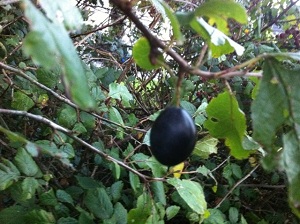
The Damson. Closely related to the Sloe/ Prunus spinosa – but – the damson or sometimes known wild plum is of the Prunus domestica. This could get confusing….
- The tree/ bush may be slightly thorny – although it generally is not.
- It’s white flowers are [also] borne in spring.
- The fruit can vary in size, but [larger than sloe] can get to about 3 inches wide
Usually sweet, but it is noted that it can be a bit acid in some. This is one of my free lunches when I’m out and about – unlike it’s wicked sister [above].
My two images above are a bit dodgy – but they show the shape, rotund versus the oval that bit better.
3. Nightshade – Solanum dulcamara
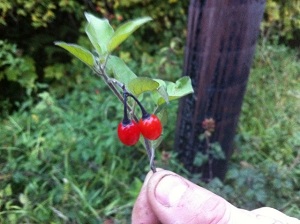
BEWARE – not to be confused with the Atropa belladonna. The extremely pretty flowers of this plant look extremely similar to that of the Solanum crispum Galsnevin, both relations or/ of the Potatoe family. It is the fruit however that I’m holding in this picture above.
It is noted that it can be used in herbal remedies, but the trouble is it is also noted to have caused deaths. The bigger problem is that it may be confused with the deadly nightshade/ pre-mentioned belladonna, one of the most poisonous plants known to man. The poison in this case believed to be solanine.
4. Rose Hip
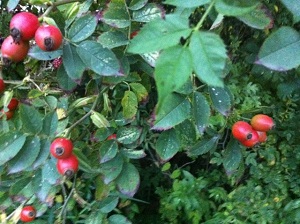
– Rosa canina. Found in hedgerows and competing quite well with the other vigours of the plant world, the rose hip is one of the greatest sources of vitamin C. The seeds can cause irritation [itchy-backs, anyone ? ] and I have never eaten them raw when I’m out and about – mainly as they taste diabolical and one seed swallowed would cause severe discomfort.
I have however used them to make rosehip syrup and with 20 times more vitamin C than an orange – this for me is the miracle cure for all of my winter snuffles. I couldn’t live without it…. if you know what I mean.
This as I know it is the ideal recipe for Rosehip syrup – the olde but a goldie.
5. Blackberry – rubus fruticosus
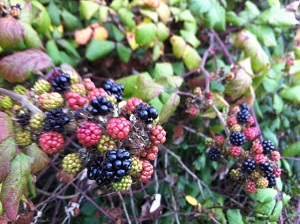
The blackberry golden rule for me is that [yes you guessed it] it must be black and it must come off in my hand with little to no effort. You possibly don’t need to know much regarding this one but funnily enough its [official plant] family is also the Roseaceae or rose – the exact same as that of the Prunus and therefore also includes as relations the Sloe and the Damson.
My only problem, as a human, is that I’m in competition with the animal kingdom for this food. That said my tip here is that you will find the lower fruit is by far the juciest!
That said, it is something I have picked as a child I fondly remember my Mom making jam with when I was a nipper. Personally, I like knowing it is there and similar to the Damson, knowing there is such a thing as a free lunch.




